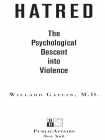Hatred, Willard Gaylin [best ebook for manga txt] 📗

- Author: Willard Gaylin
Book online «Hatred, Willard Gaylin [best ebook for manga txt] 📗». Author Willard Gaylin
HATRED
AS A THOUGHT DISORDER
6
UNDERSTANDING “NORMAL” BEHAVIOR
When an eighteen-year-old girl straps a fifteen-pound explosive pack—loaded with nails in order to maximize the extent and degree of slaughter—around her waist; enters a marketplace that is filled with other young women shopping for their evening meal; and proceeds to blow herself up for the singular purpose of crippling, maiming, blinding, and killing as many of her fellow creatures as possible, we are appalled. This is not how normal people behave. This is not consonant with the standards of human conduct as we understand them. We would assume the woman was psychotic—at least we would have assumed that in former times.
There have always existed among us those aberrant, unfortunate souls, those psychotic individuals, who have lost touch with reality and live in their own distorted world with its seemingly inexplicable sets of rules. Each thinks that he is the new Messiah, the Angel of Death, a special agent of the president of the United States, and each acts accordingly. We try to understand their illness and be forgiving of their actions. But we are not always successful, since their behavior is so alien to our sense of normal human conduct. Still, we draw a clear distinction between their behavior and the cultural standards of normalcy. Their random slaughter seems unmotivated, bizarre, and therefore monstrous.
What astonishes us with the Arab suicide bombers is that in their own community this behavior is perceived as rational. Beyond acceptance, it is actually glorified. Such conduct is elevated to a model to be embraced, admired, and emulated by their peers. Perhaps it is cynical to point out that many parents of the Palestinian suicide bombers have been paid $25,000 by Iraq and supplied a home and other comforts rare in these cultures of poverty. Children have been sold into slavery and prostitution in Africa, India, Pakistan, the Philippines, and other impoverished regions for a fraction of this amount. Still, the parents of the terrorists seem to take pride and joy in their children’s behavior. Other parents aspire to the same fate for their children—or at least affect to.
And the religious leaders—the guardians and arbiters of morality in their community—join the political demagogues in celebration and endorsement of the murder and self-destruction. They do worse; they proclaim the bombers to be martyrs. It is positively dumbfounding to us that they idealize these monstrous acts, defining such behavior as being in the service of Allah—in the service of God, no less.
Is it possible to view terrorism as simply a function of cultural variability? Given the disparate potentials of human behavior, should we acknowledge terrorism as an authentic example of cultural diversity? Can we acknowledge it as normal behavior? Or are we entitled to label such action as a perversion of human nature?
The diversity of human behavior is astonishing. Each human infant is born incomplete, awaiting the variable impacts of family and culture to determine what emerges. Environmental influences modify the genetic structures and thus the very form and nature of human life in ways impossible with any other animal. And the line between normal and sick behavior is as porous a boundary as the border between Afghanistan and Pakistan. Defining sick behavior is contingent on defining the normal, and that is not so easy, given the singularity of the human species, the range of normal lifestyles available to our species, and the diversity of our behavior and our cultures. We must understand the boundaries of normalcy.
The arguments about normal and perverse—hatred and evil—are but part of an ongoing dialogue about human nature itself. Two contrasting views prevail. One is expressed most clearly in the beginning of the Old Testament: “So God created man in His own image, in the image of God created He him; male and female created He them.”23 This statement definitively places man apart from the continuity of the beasts. Being in the image of a righteous and just Lord, man must by nature be endowed with goodness. And as the Bible later confirms: “Thou hast made him but little lower than the angels, and hast crowned him with glory and honor.”24 The Bible, in allowing our species the freedom to rebel, gave rise to the Christian doctrine of original sin. Whereas the Old Testament emphasizes an inborn goodness that is corruptible, the New Testament emphasizes an inborn corruptness that is correctable.
The view from the second half of the twentieth century—conditioned by two world wars, the Holocaust, the atom bomb, and growing ecological disasters—lent credence to an opposing view of human nature supporting those who viewed human nature as inherently selfish and evil. The world of modern anthropologists and ethologists tended to support a gloomy view of man as the destroyer. 25 These sociologists may be seen as the descendants of Montaigne, the most extreme spokesman for the vileness of natural man. Montaigne viewed man as not just an animal, but a lesser animal. The very traits that are generally proposed as our glories—our freedom and autonomy—were perceived by him as primarily the freedom to do evil. As such freedom is a baser phenomenon than the instinctually driven behavior of lower animals.26
The negative view of nature has been buttressed by the powerful emotional impact of evil since 9/11. This view is also supported by our tendency to be more fascinated by evil than virtue, discomfort than comfort, sickness than health. Look at the evening news. One manifestation of the view that we are innately evil, needing civilization to live in





Comments (0)